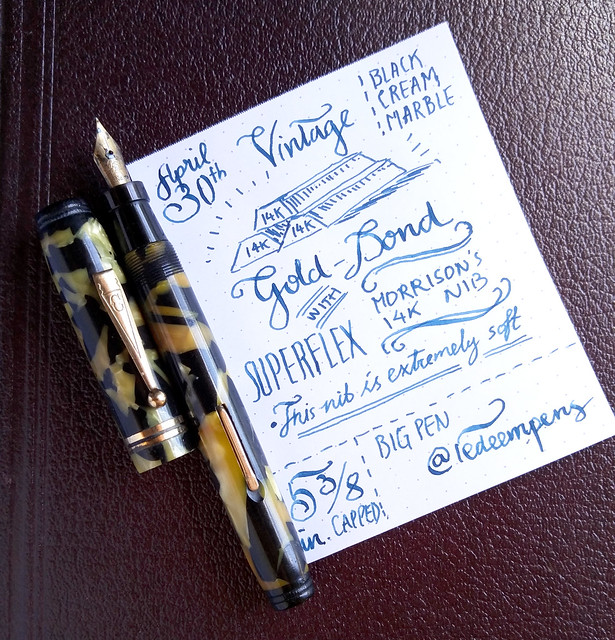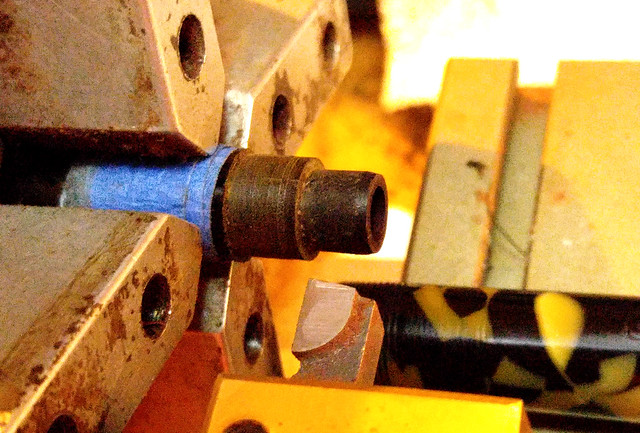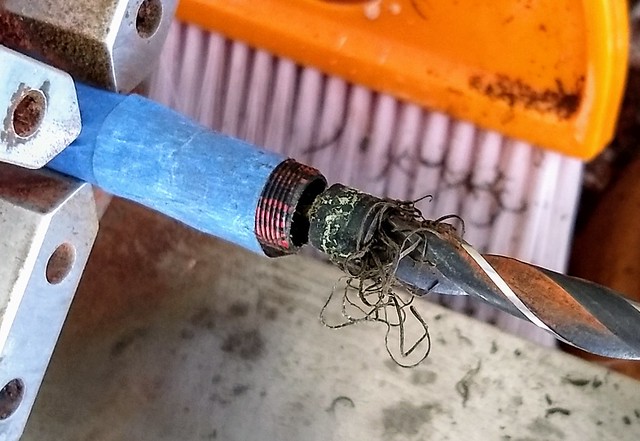The Fascination with Gold Bond
Just to be clear, here we are talking about Gold Bond fountain pen brand, not foot powder or ointment.
Gold Bond pens were marketed by Montgomery Ward in the 1930s in both their catalog and their stores, so they were pretty well-known merchandise in those days.
Interstingly, today it seems that except for me and a few others, these wonderful pens are not well known in the entire fountain pen collector community.
Some dismissed it as just another "third-tier" pen brand, but to me, as long as a pen is objectively made well and of high quality, it can be welcome in my collection. I don't care if it wasn't the top most popular brands, it makes even less sense for me to limit my collection that way.
So this is the chronicle of the Gold Bond pens that I discovered and restored over the years.
#1 The Big Gold Bond (restored in 2017)

You have no idea how much I've been waiting for this Gold Bond brand pen to "rise from the ashes".
Last year the barrel and cap of this pen came to me, and I immediately like it because of its size, and I can tell that this pen used to occupy the top tier model.
But Issue #1, the section was missing and being a big pen (usually vintage pens are smaller) it's hard to find a section that would fit it, not to mention the one with a nib size that won't look ridiculously small.
Issue #2 is the clip. No clip came with the cap, just a stub that used to be a clip. Now what? Well, nothing else to do until an appropriately sized Z-clip come by. And one finally did, thankfully not costing me a lot like a seller on ebay wants for one. And it came with a nice "C" engraving. "C" for Cold Bond? 
Okay, so now I had to borrow the inner cap puller from my FP restoration "master" and after soaking the cap for a few days, I finally were able to get the old inner cap out. Old clip stub out, new Z-clip in, and reinstall the inner cap with a lot of fitting and careful tapping. Careful is the key here, because one tap too many, I can crack the cap from the inside. Game over.
Back to Issue #1, what section will fit this beast? I tried about 10 different sections and modify 3 of them only to end up with non-satisfying creaky fit.
Fast forward to last week, enter the Morrison's 14K nib in a heavily stained Mandarin yellow barrel with no cap <--- it's amazing that the nib survived without a cap in the middle of basically a heap of junk, it was snuck up inside a batch of battered and broken bunch of pens I got from ebay. I didn't even remember seeing this pen in the photo. But the moment I hold the section, I knew I can use it for the Gold Beast. Some quality moments with the lathe later

It fits like the glass shoe on Cinderella now.
So now the 64K question is: Why draw gold bars in the writing sample? I don't know, Gold Bond, Gold Bar... not enough coffee? 
#2 The Woodgrain Stonite (restored in 2019)
Two years later, here I am with another tale of restoration featuring... another Gold Bond 
I guess my obsession with Gold Bond has become quite ridiculous, I just love those knurled ends. And this one is a very pretty woodgrain ebonite (or at least I think it's ebonite since I smell a faint sulphur if I rub the barrel/cap). The yellow finials are celluloid though.
I got this pen knowing that there is at least one problem, but little that I know when I got it, that the section was "cemented" to the barrel (no amount of heat or immersion would loosen the section). How? I suspect the type of ink that was used last in the pen. The ink may leaked out of the old ink sac and formed a bond between the section and the barrel. I've seen this happening to a Wahl before.
Examine this photo:
That was the barrel, in my lathe, I drilled out the section which was already marred because the previous owner probably lost their patience and try to take the section out using a (non rubberized) plier, resulting in gashes. Amazingly I was able to rescue both the nib and the feed by working slowly on the lathe to thin out the messed up section, until I can take the feed out to safety.
Then I use two sizes of drill from smaller to bigger to take out the section. This photo literally was taken seconds after the section finally "squirmed" itself out of the barrel without a single crack on the barrel lip (yes, I sighed a breath of relief...).
Notice the white residue on the section, it was inside the barrel also (a long scraping session ensued) that was the stuff that bonded the section to the barrel. And yes, the feed was full of this gunk also, that's why I suspect the type of ink used.
After taking the section out without harming the barrel, I was able to find a suitable replacement from my collection of sections
Voila!
And here's the section in its new home
#3 Another Woodgrain Stonite (restored in 2020)
Aaaand, another woodgrain ebonite Gold Bond.
This one is similar to the one I posted above, but with a different cool Art Deco style clip.

On this one I do have to swap the nib with an Eversharp because the one that came with the pen was not an original Gold Bond, and it was poorly fitted.
